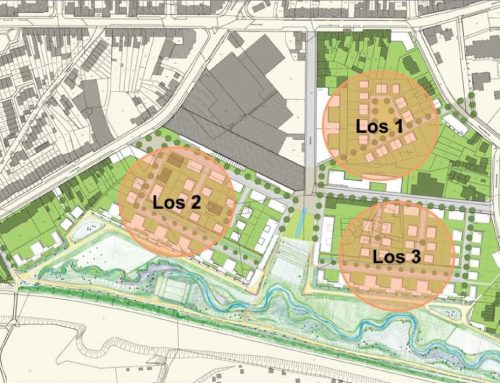In challenging times for the real estate industry, the Development Corporation of the City of Mönchengladbach (EWMG) managed to conclude the fiscal year 2022 positively. New residential building plots were sold, and projects such as the new construction at Rheydt main train station made progress. In 2023, EWMG, together with the administration, is making every effort to further advance flagship projects in Mönchengladbach and create new housing.
In 2022, the revenue reached €16 million, surpassing the previous year’s level (2021: €12.4 million) but falling short of the plan by approximately €2.5 million. The rental and leasing business remained stable at the projected €4.7 million, compared to the previous year (2021: €4.5 million). “The crisis in the real estate sector has led to a decline in profitability at EWMG,” explains Dr. Ulrich Schückhaus, CEO of EWMG. “We were unable to achieve the planned sales revenue to the fullest extent, and the transaction volume of acquisitions and sales decreased by nearly €3 million compared to the previous year. Due to high costs and uncertainties in the construction industry, investors are putting their projects on hold, and private builders are withdrawing their bids.” Therefore, Schückhaus expects a negative operating result of approximately -€400,000 for 2022 but a net profit of €2.1 million, primarily due to the NEW dividend.
Additional Housing
Residential construction in Mönchengladbach is progressing at different rates. While some inner-city neighborhood developments are experiencing delays, construction continues in the Seestadt area. The first 248 apartments have been built, and some tenants have already moved in, with the second phase to follow. The residential developments, including publicly subsidized housing, on Waldhausener Straße and in the Croonsquartier are also gaining momentum. “These are good news and important signs for Mönchengladbach in difficult times. We are doing everything we can to further advance the planned projects because we need private and commercial investors to create housing for everyone in the city,” emphasizes Janann Safi, Chairman of the Supervisory Board of EWMG. The numbers underscore this statement: In 2022, EWMG invested a total of €7.3 million in construction and development measures.
Private builders found opportunities in two residential areas last year. With the second phase in Bettrath and the Kruchenstraße development in Giesenkirchen, EWMG marketed nearly 50 plots of land. With the exception of seven reservations on Kruchenstraße and one in Bettrath, all the areas have been sold. Additional building plots in Venn (Hamerweg/Stationsweg development) will follow by the end of 2023. Approximately 100 residential units will be realized in row houses and apartment buildings. Construction work for the central playground for the Venn district will also commence here in the summer. The marketing of up to 15 single-family and duplex house plots in Lot 1 of the REME area is planned for 2024.
Impulses for the City Center
By the end of 2024, the new Central Bus Station (ZOB) will be built at Mönchengladbach Central Station. It will be a modern, high-performance, and demand-oriented mobility hub. “This is an important step to realign the Europaplatz as a whole and to carry out urban redevelopment, especially at this prominent location,” says Dr. Gregor Bonin, City Director, who also refers to the neighboring project, 19 Häuser, even though the longstanding negotiations with the investor BEMA have been discontinued. “Our goal is still to implement the design by the Hamburg-based KBNK Architekten, which was selected at the time.” Separate developments on the municipal and BEMA areas, as well as implementation by a third party, are conceivable. “An attractive mixed-use neighborhood in close proximity to the main train station as a new gateway to Mönchengladbach will have a positive impact on the city’s overall image. Especially in difficult times, we can set sustainable signs with this project.”
The same applies to the plans for Hindenburgstraße, aiming to connect the shopping street with the historically significant Abteiberg through a visual axis. The plans for the necessary breakthrough to Museum Abteiberg have progressed further. The city intends to submit the corresponding funding application for the enhancement of the Obere Hindenburgstraße urban quarter in autumn 2023. “Architect Hans Hollein had planned the direct connection between Museum Abteiberg and Hindenburgstraße himself, which unfortunately has not been realized so far,” explains Bonin. With the demolition of the buildings on Hindenburg- and Krichelstraße, which are already owned by the city or EWMG, and the enhancement of Hindenburgstraße at this location, a generous open space would be created, offering an attractive, green, and open entrance to the museum, thus completing Hollein’s vision for the museum. “One of the most important urban planning tasks in the coming years and decades will be to create quality public spaces in the city center to ensure long-term viability and establish it as an attractive central place for shopping, services, gastronomy, and living.”
Progress in Building Construction
EWMG is investing directly in Rheydt Central Station. In April, they celebrated the topping-out ceremony for the new reception building with all stakeholders. Dr. Schückhaus symbolically drove in the last nail before the interior construction and facade and electrical works begin shortly. “It’s great to see that the development at Rheydt Central Station is taking shape after many years of negotiation, discussion, and preliminary work,” says Schückhaus. Moreover, despite the current challenges in the construction industry, the project is on schedule. “We are making a visible statement for the Rheydt district and, therefore, for the entire city.” Unique job opportunities are being created here as well, including modern, bright office spaces and commercial areas, a green courtyard, retail spaces at the doorstep, and perfect access to public transportation. Schückhaus concludes, “We remain committed to further developing Mönchengladbach for its residents.”











